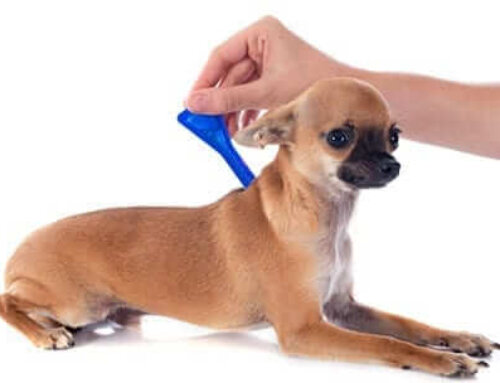Two weeks ago I had a client who forced my hand and made me do a pet glucose curve in my clinic. Normally I expect, and strongly encourage, my clients to run their curves at home to avoid the complication of “stress hyperglycemia”. This phenomenon is when the liver turns stored glycogen into glucose when a pet is stressed. It’s the old fight or flight response from the stress of being at the clinic. Her dog is a newly diagnosed diabetic and doing remarkably well on Levemir, but we needed to evaluate the dosage. This owner is quite smart. I really enjoy her. Unfortunately, she feels so guilty getting blood from her little cavalier that checking her dog’s blood glucose completely stresses her out. She believed she couldn’t check a curve at home, so I conceded and ran the curve in the clinic.
Pet Glucose Curves and Anxiety
This little dog did NOT like being in a kennel at my clinic and got put in the quiet kennel area in the back for noise sensitive pets. I’m certain the pet thought: “Why are these humans treating me like a dog? Why am I in a cage? I better bark nonstop and alert them that I’m in a kennel!”
I’m certain she had some stress hyperglycemia just from being kenneled. At one point during the day I walked into the room to check on her, and she was digging to China at the kennel door. I adjusted the dose, knowing the results would be affected by stress hyperglycemia, and spent time with the owner having another lesson on checking the pet’s blood glucose later that day.
I’m proud to say she did the curve by herself at home last week although she didn’t enjoy doing so. What she told me was that she felt guilty poking her pet to get the glucose for each reading. Maybe this is why some of my most earnest clients dawdle when I ask them to run a curve. Ideally we check the pet glucose curve 5 to 7 days after any change of insulin dose or every 3 months even if we think we have the dose perfect.
Years ago I read a survey result that diabetic humans feel more adverse to poking themselves for blood than to poking themselves with a needle to give themselves insulin. This emotion is likely amplified when the poke and sight of blood involves a beloved pet. Seriously, some folks get woozy at the mere thought of blood or needles.
Don’t Worry
Let’s get back to my client telling me she felt guilty each time she checked a blood glucose. Yes, a quick poke with a Petfine Autolet lancing device hurts for a second. But that is really just a handful of brief pokes, a few brief instants of slight discomfort. If a pet is not on the best dosage of insulin, if it is unregulated, it feels crummy all day long, day after day.
What are the signs of poorly managed diabetes? Well, we know when the blood glucose is really high the pet is voraciously hungry, drinks excessively, loses weight and acts lethargic. What about a mildly elevated blood glucose? The pet may not be losing weight nor feeling horrible, but may have subtle clinical signs and feel unwell, unnoticed by the pet owner.
If we anthropomorphize the clinical signs of diabetic humans onto our pets we can assume they may also:
- Feel nauseous when the blood glucose is elevated
- Have a dry mouth
- Have subclinical urinary tract infections
- Feel lethargy or fatigued
- Have decreased vision
Don’t Delay
So maybe you have dawdled about running your pet’s latest blood glucose curve because you feel badly about poking your pet. Are those handful of pokes with a lancing device worse than your pet feeling lethargic or having a dry mouth all day long? I think not.
Humans get to make the choice about their health. If they are diabetic, they can choose to eat healthy foods and exercise and monitor their sugars. Or, they may eat donuts and candy and have to pee in the night and experience other effects of unregulated diabetes. Folks make these choices for themselves and live with the consequences. Having a diabetic pet is indeed a responsibility. It is our responsibility to our beloved pets to do our best for them when they have medical conditions.
I understand if clients have a busy schedule. As my own vet practice grows I’m back to working 50 to 60 hours a week these days. Anymore I really look forward to weekends so I can catch up on the rest of my life. I understand how precious time is. I also understand that some clients hate the sight of blood, even if just a teeny droplet for a blood glucose check. And now I also understand how a client may fear hurting a pet by using a lancing device.
Pet Glucose Curves at Home
Really, the vast majority of pets tolerate home glucose testing quite well. The blood glucose readings at home eliminate stress hyperglycemia. It’s a quick poke and if you rub the area prior it doesn’t hurt much. Some lancing devices are better than others. I prefer lancing devices with an adjustable depth, so you poke only as deeply as needed. I send my clients with a little sock of uncooked rice that they can warm in the microwave and hold against the site of blood collection. The warmth causes the blood vessels to dilate so the pet bleeds more easily. And of course, hug and talk to your sweetie to distract your pet from the actual poke. And know that these few seconds of mild discomfort are for the greater good.
You want your pet to be well regulated and feel good all day long!
Have a question or comment? Then post below! I always enjoy hearing from my readers!
NOTE: Consult your veterinarian first to make sure my recommendations fit your pets special health needs.











Hi, my 12 year old mini schnauzer has just been diagnosed with diabetes after 2 blood glucose tests. The 1st was at an emergency clinic and he had a UTI and pancreatitis (his level was 315). The 2nd test was 20 days later at a follow up (his level was 515). My first question is: is that all it takes to diagnose-2 readings? My second question is: what is a safe range for blood sugar? My vet didn’t provide any information about safe ranges, signs of hypoglycemia or hyperglycemia. I’m very worried about this and feel like I’m in the dark. I’m going to switch Vets because of lack of information and am hoping you can give some information until my appointment. Thank you for all information you can provide!
Well, with those 2 readings I’d feel pretty confident that your doggie is diabetic.
If you want a good read, go to the AAHA website. In 2018 they published new AAHA pet diabetes guidelines. Additionally, you can read my 4 part Back to Basics under the articles tab of the ADWDiabetes website.
Education is key to managing your diabetic pet!
Dr. Sutton, thanks so much for your informative articles concerning dog diabetes. I am new to it and it’s often hard to find info which helps with the concerns of caring for a diabetic dogs so personally, your articles have really helped me. I think like many of your readers, I would have no problem whatsoever doing a blood glucose curve on a human, who understands it is necessary, will benefit them, and the pain will be over in seconds. When it comes to my 13lb Chi mix however, it’s a whole other story. Sometimes I prick him and get a small drop of blood adequate for the test. Other times I poke exactly the same and either get no blood or too much. When I poke multiple times and can’t get a sample it really upsets me because he flinches, growls, or snaps then kisses me madly as an apology and I know he doesn’t understand why I’m hurting him. At the end of the day he won’t get anywhere near me. Unlike his human counterpart, he can’t rationalize why I am doing this to him and although I know it’s for his own good, I feel very badly for hurting him. I suppose I will get better at it with time and all the tips help. I will definitely try the rice, thank you! My vet gave me some numbing cream to rub on his ear but it didn’t make any difference at all other than to screw up the readings until I rubbed it off completely. May I ask you, I was told to poke the ear in the inside but I have seen many others shave the fur and do it on the outside, is one better than the other? I’ve also seen several people shave the spot of the back where the tail joins and get a sample there. Any suggestions or comments on trying there? Again, thanks so much for your time and the very informative articles.
Do try the rice in a sock trick. It often makes all the difference.
Now, the marginal ear being is usually the sweet spot, but for many pets you don’t need to shave if the pet has a meaty ear. If you take a flashlight and shine it through the ear it is super easy to see e marginal ear vein. Shaving the hair prevents the hair from wicking the blood away. If a dog has a meaty ear, you might be able to avoid a weird hairdoo. 😉
Start with the backing device at its deepest setting then as you get good at it you may be able to use a shorter setting.
It will get better!!!
Good luck!
Hi,
I really appreciate your posts! We have a 6 year old mini schnauzer who was diagnosed with diabetes last year. The curves at the vets office were off the charts even when the vet thought the dosage was close/right. I read many of your past columns, bought an AlphaTrak from our vet and watched many videos. Honestly, I think the key was the warm sock with rice. Felix is used to process now and the at home results are more consistent. Thank you for your posts and great advice Dr. Sutton!
Shucks, thanks!
Isn’t it surprising how much difference a little sock of warm uncooked rice can make for getting a blood sample?
Thanks for your kind words. 🙂
Dr Sutton I appreciate your articles so much. I don’t want my Aussie to feel crummy all day. Sometimes she looks sad. I do curves but not every 3 months. I will now! She has a callus on her elbow. This is were I check. She doesn’t seem to feel a thing. I’d like to find another area or two to check. Could you let me know where good spots are to check on a Aussie Shepherd? Sometimes I wonder how accurate it is when I’m poking the same sight over and over every two hours.
Thank you,
Linda
Linda, hallelujah that your dog has an elbow callus!!! I would keep using that site, particularly since she doesn’t act like she feels it. I think the accuracy is fine using that site repeatedly. I wish all diabetic pets had an elbow callus. 😉
Running curves more often will help you fine tune her diabetes regulation so that you can tweak her dosage before you have issues, even when you think she is doing well.
Dr. Sutton, this was a very interesting article. I am still looking for the information about what is recommended daily calories and carbs for a 14 year old 18 lb miniature schnauzer with diabetes. Thank you,
Gary, I thought I had answered you… it’s difficult to evaluate how many calories a pet requires. How much of the current weight is from lean muscle versus fat? How active is the pet? Does the pet have a fast metabolism versus a slow metabolism? Is the diabetes well regulated? All these factors can affect the caloric requirement. This is why I advised you (or thought I had when I responded earlier) that you ask your veterinarian who has examined your pet. I’ve never seen your pet to know (or guess).
If I had to make a guess, if the pet had a lean body weight, I’d guess about 315 kcalories for maintenance if the pet was completely sedentary. Obviously you’d add more for activity. The best way to know is to figure out how many calories your pet currently eats and then adjust accordingly. Is your goal fat loss? Maintenance? Weight gain?
Have a chat with your family veterinarian about this.
🙂 Joi
Great article. Very informative. My dog and I are fine with and used to checking his glucose level. I say, “Let’s check your sugar” and he lies down on his rug and even repositions his arm for me when I am ready. Now, the insulin injections are another story! He grumbles or growls at me so we both prefer to have my husband do that!
Great job, Colette!
Thank you for this important article. I have had insulin-dependent diabetes for 38 years and both of my mini schnauzers developed diabetes. Tucker, my 12-year-old, has diabetes secondary to Cushing’s disease. You can only imagine what it’s like at our house in the morning and evening before meals! Anyway, I always say God gave me two dogs with diabetes because I would know how to take care of them. Maybe it’s because I check my blood sugar before meals, at bedtime and whenever I feel “funny” but I can’t imagine not checking my dog’s blood sugar every day. I usually poke his ear to obtain a sample and he winces once in a while but most of the time, he has no reaction. He is doing exceedingly well. I have my own Alpha Trak meter and order the test strips from ADW. They have the best price and free shipping. This really helps to defray the cost of Tucker’s care. Part of the reason I’m insistent on checking Tucker‘s blood sugar levels is because he is on NPH. We are very active and occasionally his blood sugar gets low during that 4 to 6 hour range after his twice daily injections. In your article you mentioned your patient is getting Levemir. Would you please talk about your experience using that particular insulin? Thanks so much!
I really like levemir for dogs. It lasts longer than the insulins we’ve traditionally used in dogs such as NPH or Vetsulin. It can’t be diluted. And it is quite potent in dogs compared to NPH or Vetsulin. You can expect to use about a quarter of the dose of of other insulins because dogs are so responsive to it. When I use NPH I have clients get a 3 cc pen and use it as a vial rather than a 10 cc vial as it saves folks money. For little tiny dogs you may not be able to give a measurable dose, even with a small 3/10 cc syringe with half unit markings. It is my preferred insulin for dogs, but again, it may be hard to use in little bitty dogs because it is so potent and cannot be diluted.
It was terribly difficult for me to do glucose tests on my cat, at first. I couldn’t even watch the videos, the sight of the blood made me squeamish. Eventually, i knew I had to try because her glucose levels were not well regulated– sometimes too high, sometimes too low. At first, my attempts seemed so bad! I did not know what I was doing and neither did she! I sometimes would poke her multiple times, sometimes the meter would give me error messages and on and on. I felt terrible about it. But we persisted and now it is pretty much a breeze. I now understand where the best spots are to prick (close to the edge of the ear), we warm the ear up gently with a warm rice pack, I press the pricked area gently to increase blood flow, and have the meter ready to go. I also got used to what position to hold her in (which had been awkward at the beginning). Let me encourage each of you who may be considering the testing, YOU CAN DO IT!!!
Ella, way to persevere!! Great job. I’m proud of you. As formidable as it seemed at first it is now a breeze! 🙂